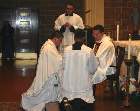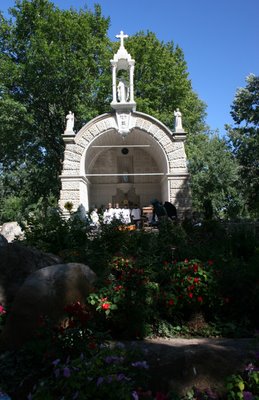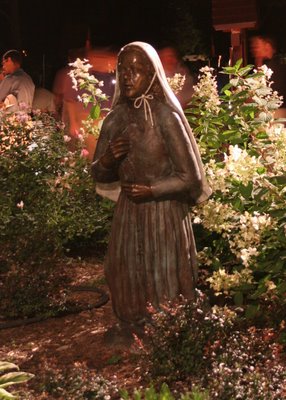The lastest issue of Homiletic and Pastoral Review is out and, as always, HPR has chosen one of its articles in the issue to be featured at its online site.
This is an excellent article and deserves some attention and reflection. But, I want to give you a lead-in to this article. In particular, I believe Catholic bloggers may want to ponder the admonishment of Fr. Morrow, who shares examples in history of where criticism, while seemingy just, can lead down a deadly path.
Catholic blogging in the internet age makes it easy to engage in criticisms of priests and bishops. Reading the article by Fr. Morrow we get a picture of what many priests and bishops were like in the 13th century. As I read it, my thoughts turned to St. Francis: How did he deal with these priests and bishops? That is where Fr. Morrow takes readers next. He compares and contrasts the acts and behavior of St. Francis in dealing with the same kinds of unvirtuous and even sinful priests and bishops, as those who lived Gospel poverty at the same time, but were openly critical (and eventually excommunicated). It's the difference between a humble, prayerful and even charitable response, and one that is prideful. Both groups cared about the Church enough to want to do something, but Francis took the high road and his efforts left others an opportunity to see their errors (not that they necessarily did).
What can we learn from this?
As a blogger, I admit that in my early writings, I had a focus on the latest, most outrageous, thing happening out there in the liturgy and in the Church. I felt the need to protect Holy Mother Church from such outrages and wanted to vent. The internet made it easy to share photos and video of what was going on. I felt myself angry inside much of the time.
One day, a young priest with whom I was close, showed disapproval for my having posted such things. This priest challenged me gently, but persistently, saying that it would be far more productive if I spent an hour in adoration in reparation for offenses that were visible to me, than to be exploiting them and being openly critical. It took some time (weeks and months) for it to sink in and now that it has, I am at peace. Gone is the constant anger and sense of outrage - neither of which are fruits of the Holy Spirit. That is why you won't find "scandal stories" in my posts of late and why I choose to focus more on leading readers to things that are spiritually beneficial. I don't even read the scandal stories on Catholic blogs any longer because they counter the Christian values which continue to evolve through the help of my confessors and spiritual directors. Furthermore, I don't want to encourage people in these kinds of posts by contributing to high hit counts.
Some of what I have read in the past, and even passed along, borders on detraction, but only God knows what is in a person's heart. I would like to think that we would not even want to come close to that line out of fear that we would offend Our Lord. Much "news" these days is actually gossip and just because it comes from a supposedly reliable source, does not make it right to pass on publicly (emphasis mine).
- CCC: 2477
- Respect for the reputation of persons forbids every attitude and word likely to cause them unjust injury.278 He becomes guilty:
- of rash judgment who, even tacitly, assumes as true, without sufficient foundation, the moral fault of a neighbor;
- of detraction who, without objectively valid reason, discloses another's faults and failings to persons who did not know them;279
- of calumny who, by remarks contrary to the truth, harms the reputation of others and gives occasion for false judgments concerning them.
Fr. Morrow's article surrounds this whole issue well and I encourage all bloggers and readers of blogs to spend some time chewing on it. Consider what you are writing, and what you are reading. Consider that each time you click a "scandal" story on a Catholic blog - even if it is about the outrageous liturgical act of the week - you encourage the writer to give more of the same by virtue of the hits.
Hit counters should never drive content. Original Sin has left us wanting juicy tidbits. It becomes easy to by-pass 10 minutes of pure spiritual reading on a blog for 20, 30 or even 120 minutes of those juicy tidbit stories - almost to the exlusion of anything truly spiritual. I should know - I'm guilty of having done this. After a while, hopefully we begin to question what attracts us to such things over the spiritual, if not our fallen nature?
If you happen to stumble across something which exposes "the sins of others" you have a choice: You can continue reading it and post on it, or you can offer a Rosary, an hour of adoration, or some other meaningful sacrifice - silently - in reparation for the offense, and for the conversion of those involved. There are proper channels for reporting things which merit reporting - first at the local level, then the Vatican. Don't post your abuse videos and photos online, send them to the bishop with a straightforward letter, written with facts, in charity, and free of emotion. If you get no response in 3 months time or get an unsatisfactory response, send the package to the proper office at the Vatican. That is good protocol; publicly "reporting" such things on the web is not.
If you want an example, look to Pope Benedict XVI. You won't hear him publicly bashing anyone. Rather, it is handled with utmost charity, even when "counsel" is given. How would the Pope feel about some of the criticisms, and tone, on Catholic blogs? Even if anger is justified, is publicly airing such dirty laundry justified? Would he be disappointed with what we write? When he "spanks" it's with a soft hand because hitting any harder would seemingly "force" people into submission when we are suppose to respond with an act of free will. Some will choose correctly with gentle prodding, some will refuse and that is the keyword - it is their choice and one that God gives to them.
Don't get me wrong. I am as upset by abuses visible via the internet as anyone. I'm just choosing to deal with it a different way these days and I'm grateful to have had a confessor who cared enough to say something.
Persecution and abuse - even from within - has been with the Catholic Church from the beginning. Jesus chose Judas, and Judas had a free will. Jesus knew what Judas would do, but he teaches us that even within the clergy there are sinners who will make bad decisions. We must leave the judgment to God and pray for the conversion of these souls and make reparation for their deeds.
Go read: The Danger of Criticizing Priests and Bishops by Rev. Thomas G. MorrowNOTE: If at any point the link does not work, please
email me. I believe the URL will change as soon as a new edition comes out and I will edit the link if someone lets me know it is not working correctly.
I would love to hear the thoughts of other bloggers or blog readers on this subject. Feel free to post comments, but if you choose to do so anonymously, at least choose a pseudo-name to make it easier to distinguish one anon from another.
Please don't comment until you have read the article by Fr. Morrow.
For other great articles, go to
HPR Online. Published by Ignatius Press, it is aimed at priests, but great lay-reading. Look at some of the titles in this month's issue on the right. They also have "sample articles" which remain online (on the left). These are lead articles from previous issues.
Better yet, just subscribe - it's one of the best Catholic periodicals out there.






















